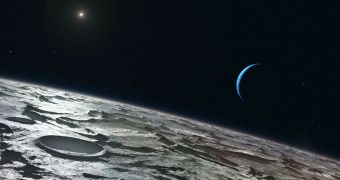Using their Chile-based Very Large Telescope (VLT), astronomers from the European Southern Observatory (ESO) managed to conduct a unique survey of Neptune's moon Triton. The investigation, which was made in infrared wavelengths, revealed an astounding fact, namely that the southern hemisphere of the small space rock is beginning to show signs of summer. The science team was also able to identify the first trails of carbon monoxide and the hydrocarbon methane on the celestial body, something that has not been shown before.
The main conclusion of the research is that Triton features a variable, albeit thin, atmosphere, which appears to increase and thicken when warmed. “We have found real evidence that the Sun still makes its presence felt on Triton, even from so far away. This icy moon actually has seasons just as we do on Earth, but they change far more slowly,” explains astronomer Emmanuel Lellouch, from the Observatoire de Paris, in France, who was also the principal investigator on the research. The expert was the lead author of a new paper detailing the findings, which will appear in an upcoming issue of the esteemed scientific publication Astronomy & Astrophysics.
“Climate and atmospheric models of Triton have to be revisited now, now that we have found carbon monoxide and re-measured the methane,” states OP expert Catherine de Bergh, who was a coauthor of the study. The group adds that the pressure on Neptune's moon is between 40 and 65 microbars, which means it's about 20,000 times lower than that on our own planet. The space rock has a diameter of about 75 percent the Earth's Moon, or some 2,700 kilometers. It is the largest of the gas giant's 13 moons, and the seventh largest in the entire solar system.
One of the reasons why experts are so interested in it is the fact that it closely resembles Titan, Saturn's famous moon. The two bodies exhibit about the same type of surface, and the discovery of carbon monoxide is bound to make even more experts interested in Triton. Finding such minute traces of chemical elements so far away from home was made possible through the use of the Cryogenic High-Resolution Infrared Echelle Spectrograph (CRIRES) instrument on the VLT. Using it, “We can now start monitoring the atmosphere and learn a lot about the seasonal evolution of Triton over decades,” says Lellouch.

 14 DAY TRIAL //
14 DAY TRIAL //